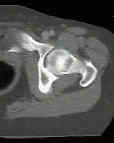- Discussion:
- femoral version is defined as the angular difference between axis of femoral neck and transcondylar axis of the knee;
- excessive femoral anteversion (medial femoral torsion) is most common cause of in-toeing that first presents in early childhood;
- it is twice as common in girls as in boys, it is nearly always symmetrical, and it is often familial;
- tripping as a result of crossing the feet may occur, and child may be teased by peers because of pigeon-toed gait and the awkward
running pattern;
- normal values:
- on average, femoral anteversion ranges from 30-40 deg at birth and decreases progressively throughout growth to about 15
deg at skeletal maturation;
- in adults, anteversion averages between 8 and 14 deg, w/ an average of 8 degrees in men and 14 degrees in women;
- diff dx of intoeing:
- metatarsus adductus
- tibial torsion
- femoral anteversion
- natural history:
- parents usually become concerned after the child reaches age 3 years;
- in-toeing secondary to medial femoral torsion is most pronounced between ages 4 to 6 years, but subsquently improves during
later childhood, averaging about 1.5 degrees of correction per year;
- this is partially due to fact that medial hip rotation is greatest during early childhood, but then declines w/ increasing age,
decreasing about 2-3 deg/year;
- if assoc w/ internal tibial torsion, femoral anteversion may lead to patellofemoral subluxation due to an increase in Q angle;
- both the decrease in femoral anteversion and decrease in medial rotation, result in near complete resolution of the intoeing in
more than 80 % of affected children, usually by age 10 years;
- additional concious compsensation may occur during adolescence;
- Exam:
- increased medial rotation and decreased lateral rotation noted on exam of child with intoeing gait with patellae medially rotated;
- medial rotation of thigh in extension exceeding 70 deg is abnormal;
- if hip rotation is asymmetric, then consider DDH;
- gait:

- child ambulates w/ patella medially rotated, and runs in an awkward pattern;
- running is characterized by medial rotation of thighs during swing phase, which causes outward rotation of legs;
- Reider Test:
- prominence of the greater trochanter indicates axis of the femoral neck;
- noting the position of the patella, an accurate determination of the femoral anteversion can be determined;
- Operative Inidcations:
- procedure should be performed only after age of eight to ten years, for persistent, severe deformity;
- child should have more than 50 degrees of measured anteversion & more than 80 degrees of medial hip rotation;
Femoral Version Abnormalities Significantly Outweigh Effect of Cam Impingement on Hip Internal Rotation
Clinical determination of femoral anteversion. A comparison with established techniques.
Intertrochanteric versus supracondylar osteotomy for severe femoral anteversion.
Medial femoral torsion and osteoarthritis.
Lower-extremity rotational problems in children. Normal values to guide management.
The anatomy and functional axes of the femur.
Femoral anteversion and physical performance in adolescent and adult life. Staheli LT, et al. Clin Orthop Rel Res 1977;129:213.

